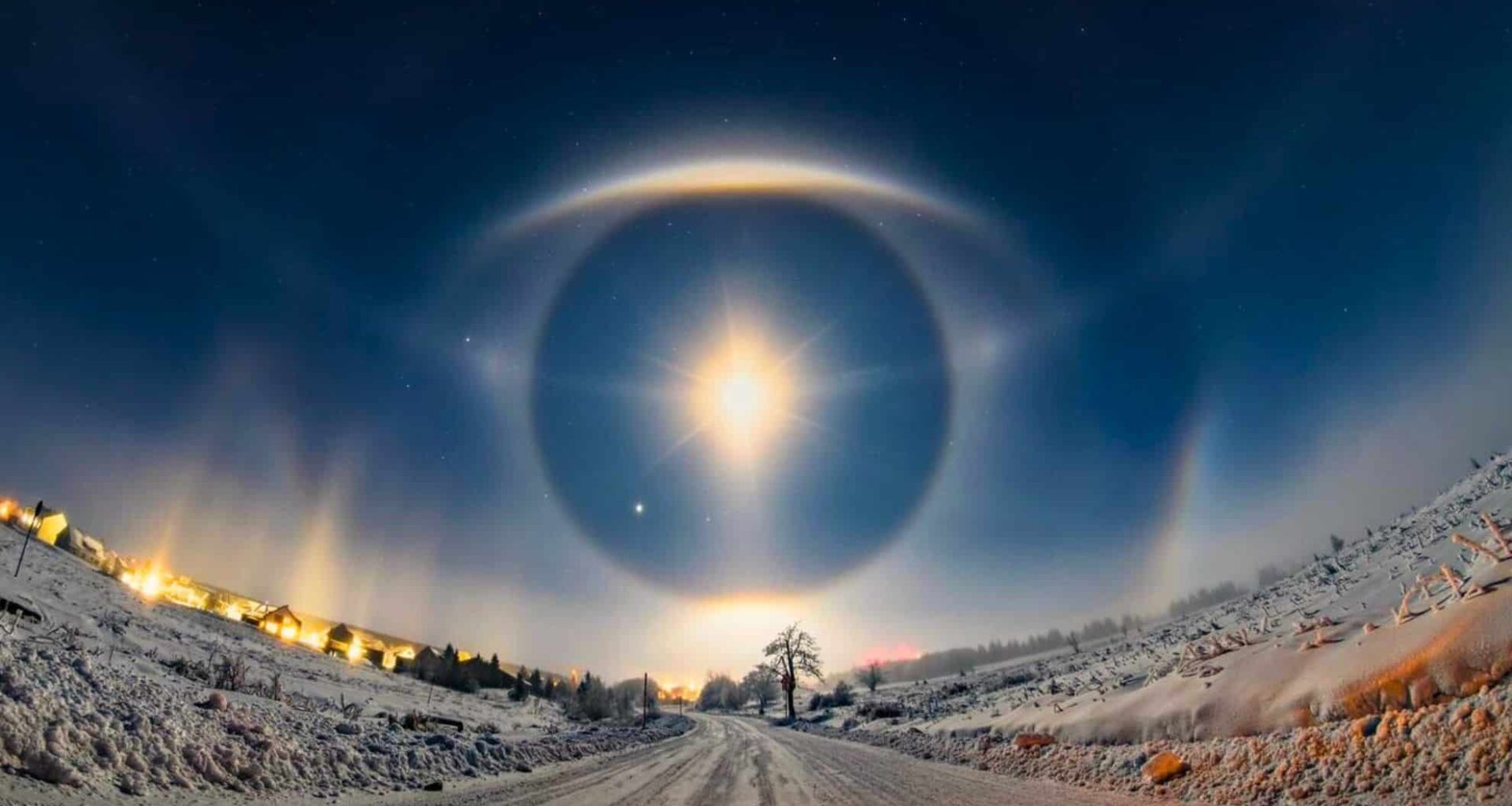A rare atmospheric phenomenon captured in the Czech Republic has caught the attention of the World Meteorological Organization (WMO) and astronomers worldwide. The image, taken by photographer Jaroslav Fous in the Ore Mountains, depicts a symmetrical lunar halo that closely resembles a glowing eye—a vivid example of how light and ice interact under precise environmental conditions.
The illusion was formed not by digital manipulation or artificial intelligence, but by a real and well-documented optical event. Using only a camera and the clear mountain air, Fous captured multiple rare halo features simultaneously—a feat that earned the image an honorable mention in the WMO’s 2026 calendar competition.
What sets this event apart is not just the beauty of the display, but its origin. The ice crystals responsible for the halo were likely not naturally suspended in the upper atmosphere. Instead, they appear to have come from snowmaking machines at a nearby ski resort—raising fascinating questions about how human-made environments can amplify natural phenomena.
How Ice and Moonlight Created a Near-Perfect Optical Illusion
Lunar halos form when moonlight is refracted through hexagonal ice crystals, typically in high-altitude cirrostratus clouds. The most common effect is a 22° halo, a ring encircling the Moon or Sun at a constant radius. Under ideal conditions, rarer optical components emerge, including tangent arcs, parselenic circles, and mock moons (also called moon dogs), which appear on either side of the halo.
In this instance, the halo was especially complex. The image showed a 22-degree ring, partial hints of a 46-degree halo, and other arc structures created as light passed through the suspended crystals. According to NASA’s Atmospheric Optics division, these halos occur when crystals are flat and well-aligned—conditions rarely sustained long enough for clear observation.
‼️✨ “Diamond dust” – tiny ice crystals reflecting sunlight or moonlight, creating halos, arcs, and eerie illusions. This amazing image was captured by Jaroslav Fous in the Czech Republic’s Ore Mountains. Rising Moon through icy fog sparked moon dogs, tangent arcs, a parselenic… pic.twitter.com/Jwdk2cfqXm
— Yuri Beletsky (@YBeletsky) July 6, 2025
What makes this case unique is that the ice crystals were almost certainly produced by snow cannons. Known as diamond dust, these microscopic particles mimic naturally occurring ice fog. In cold, still air, they can remain suspended long enough for refracted light to form full halos. While typically observed in polar regions or during extreme cold spells, diamond dust halos have been increasingly reported in ski areas where artificial snow is used.
World Meteorological Organization Highlights Rare Event
The World Meteorological Organization receives thousands of photo submissions each year for its annual calendar, but only a small number are recognized for scientific clarity and visual quality. Fous’s image, submitted anonymously before being credited, was awarded an honorable mention—a distinction that highlights its unique contribution to the documentation of atmospheric optics.
The WMO praised the image as a clear and exceptionally structured demonstration of rare halo elements. Events like this offer more than aesthetic value; they provide real-world examples of light physics in action, reinforcing fundamental principles of atmospheric science.
The image reached wider audiences when shared on social media by astronomer Yuri Beletsky, who has a background in astrophysical imaging and works at the Carnegie Las Campanas Observatory in Chile. In a tweet dated July 6, 2025, Beletsky wrote:
“Diamond dust – tiny ice crystals reflecting sunlight or moonlight, creating halos, arcs, and eerie illusions. This amazing image was captured by Jaroslav Fous in the Czech Republic’s Ore Mountains. Rising Moon through icy fog sparked moon dogs, tangent arcs, a parselenic circle, and a 22-degree halo with Jupiter and Mars inside. Light pillars glowed on the horizon.”
He added that he had adjusted the image’s colors slightly for presentation purposes, but confirmed the optical structures were naturally formed and captured in a single exposure.
Artificial Snowmaking May Open New Windows for Research
The accidental role of snowmaking technology in generating diamond dust has caught the interest of atmospheric scientists. While artificial snow is primarily a recreational tool, the ice particles it produces mimic those found in natural halo-generating environments. This raises the possibility that ski resorts and mountain facilities could serve as informal laboratories for optical studies, under the right thermal conditions.
Research from institutions like the National Center for Atmospheric Research (NCAR) has highlighted how aerosol particles and artificial cloud formations can influence visibility, optics, and localized weather. Though the Ore Mountains event was not part of a formal study, it offers anecdotal support for the idea that human-altered microclimates can trigger—or at least enhance—optical displays traditionally associated with unspoiled environments.
Still, halo events like this remain inherently rare. The alignment of ice particle type, orientation, and lighting must be exact. Even with artificial ice in the air, only a narrow window exists in which such displays can be seen and photographed. In this case, that window lasted just a few minutes.

